If you own a riding lawn mower, you’re already aware of the luxury it offers compared to pushing a standard mower.
What many homeowners, landscapers, and property managers don’t realize, however, is that these machines can do much more than just cut grass.
With the right attachments, your riding mower transforms into a multi-functional yard tool that saves time, energy, and money.
Whether you need to keep your lawn healthy, maintain your garden, clear debris, or even plow snow in winter, there’s an attachment designed to make your mower more versatile.
In this guide, we’ll dive into the best riding lawn mower attachments, their uses, benefits, and tips for getting the most out of them.
🌱 1. Lawn Sweeper – Quick Cleanup Made Easy
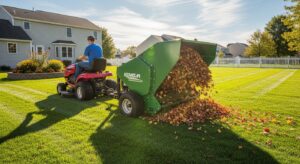
After mowing, you’re often left with a mess of grass clippings, fallen leaves, twigs, and pine needles scattered across the yard. Cleaning them manually with a rake is not only exhausting but also time-consuming. That’s where a lawn sweeper comes in.
This attachment hooks to the back of your mower and sweeps debris into a hopper as you drive. Some larger sweepers can hold up to 25 cubic feet of material, meaning fewer trips to empty the load.
-
Best Use: Clearing leaves in the fall, cleaning up grass clippings, and maintaining a neat yard.
-
Pro Tip: Pair it with a compost bin, dump the collected material directly into the pile for eco-friendly lawn recycling.
🍂 2. Mulching Kit – A Healthier, Greener Lawn
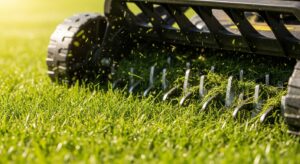
Mulching is one of the easiest ways to naturally feed your lawn. Instead of bagging clippings, a mulching kit finely chops them and redistributes them into the soil, returning nutrients like nitrogen to the grass.
Not only does mulching save you the effort of emptying collection bags, but it also reduces reliance on chemical fertilizers.
-
Best Use: Maintaining a lush, green lawn throughout spring and summer.
-
Pro Tip: Always use sharp blades for cleaner cuts; dull blades shred grass and can stress your lawn.
🚜 3. Dump Cart or Utility Trailer – Heavy Lifting Made Simple
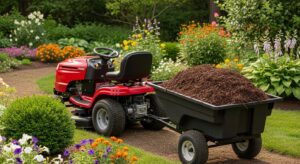
One of the most versatile attachments is the dump cart or utility trailer. Imagine moving firewood, rocks, mulch, soil, or even tools without breaking your back. With a quick hitch, your mower becomes a mini tractor capable of handling heavy-duty work.
High-quality carts feature a dumping mechanism, allowing you to unload materials in seconds. For homeowners with larger yards or gardens, this is a must-have tool.
-
Best Use: Landscaping projects, transporting heavy loads, hauling debris.
-
Pro Tip: Choose a poly bed cart; it’s rust-resistant and easier to clean than metal alternatives.
❄️ 4. Snow Blower Attachment – Winter Warrior
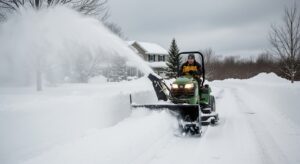
When winter arrives, your riding mower can still earn its keep. A snow blower attachment mounts to the front and clears wide paths quickly, making it perfect for long driveways. Unlike walk-behind blowers, this option is faster and requires much less effort.
Most models can throw snow up to 40 feet away, and with adjustable chutes, you can direct snow exactly where you want it.
-
Best Use: Heavy snowfalls and long driveways.
-
Pro Tip: Invest in tire chains or wheel weights for extra traction on icy surfaces.
❄️ 5. Snow Blade or Plow – Push, Don’t Shovel
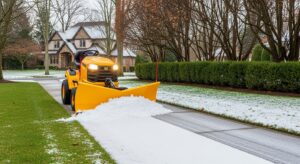
For lighter snow, dirt, or gravel, a snow blade is an affordable alternative. Mounted on the front, it allows you to push material aside easily. Though not as powerful as a blower, it’s highly effective for smaller jobs.
-
Best Use: Small driveways, sidewalks, and dirt leveling projects.
-
Pro Tip: Angle the blade slightly to one side for cleaner snow removal paths.
🌿 6. Aerator Attachment – Stronger Roots, Healthier Grass
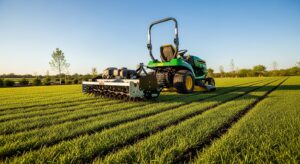
Compacted soil is one of the biggest enemies of a healthy lawn. An aerator attachment punches small holes into the ground, improving airflow, water absorption, and nutrient penetration.
The result? Stronger roots, thicker grass, and improved overall lawn health.
-
Best Use: Aerating in early spring and fall to prep lawns for the growing season.
-
Pro Tip: Water your lawn a day before aerating to make the soil softer and easier to penetrate.
🌾 7. Spreader (Seed & Fertilizer) – Even Coverage, Better Growth
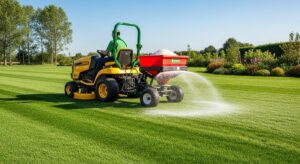
If you’ve ever fertilized or seeded by hand, you know how uneven the results can be. A spreader attachment ensures consistent distribution across your lawn.
Tow-behind models cover large areas quickly, making them perfect for reseeding or fertilizing big properties. Some spreaders can also distribute ice melt in winter, making them a year-round tool.
-
Best Use: Overseeding, fertilizing, or applying lawn treatments.
-
Pro Tip: Calibrate the spreader before use to avoid over-fertilization, which can burn your lawn.
🌱 8. Dethatcher or Lawn Rake – Remove the Barrier
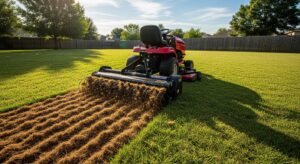
A dense layer of dead grass and organic matter prevents water and nutrients from reaching the soil. A dethatcher attachment lifts thatch from the ground, allowing your lawn to breathe again.
Used regularly, dethatching prevents bare patches and improves the overall look of your grass.
-
Best Use: Spring and fall lawn cleanup.
-
Pro Tip: Follow dethatching with sweeping or bagging for a clean finish.
🪵 9. Lawn Roller – Smooth & Professional Finish
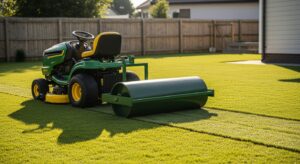
If your yard looks uneven, a lawn roller is the solution. It presses down bumps, smooths out sod, and helps with seed germination by improving soil-to-seed contact.
Fill it with water or sand for more weight, and you’ll achieve that golf-course-style finish in no time.
-
Best Use: After seeding, sodding, or fixing mole damage.
-
Pro Tip: Avoid using it when the soil is wet—it may compact the soil too much.
🛠️ 10. Front-End Loader – Mini Powerhouse
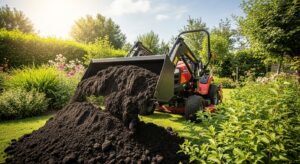
For large properties or small farms, a front-end loader attachment is a game-changer. It turns your riding mower into a small-scale loader capable of moving soil, gravel, mulch, and even snow.
These attachments are pricier but save countless hours on big projects.
-
Best Use: Landscaping, construction, and farming tasks.
-
Pro Tip: Only compatible with heavy-duty mowers—check your model before investing.
🪣 11. Sprayer Attachment – Big Coverage, Less Effort
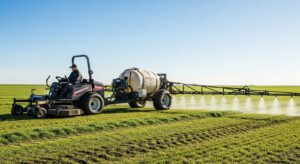
Spraying weeds, pests, or fertilizers by hand is inefficient. A sprayer attachment covers large areas evenly and quickly. Tow-behind sprayers can hold 15–25 gallons of liquid, making them ideal for big lawns or gardens.
-
Best Use: Weed control, insect treatment, and liquid fertilization.
-
Pro Tip: Always clean the sprayer after each use to prevent cross-contamination of chemicals.
🌼 12. Spiker/Seeder Combo – Two-in-One Efficiency
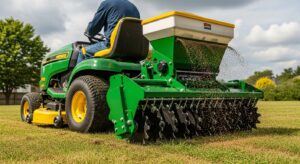
Why do two jobs separately when you can combine them? A spiker/seeder combo punctures the soil while dropping seeds simultaneously. This ensures better seed-to-soil contact, leading to faster germination and stronger grass growth.
-
Best Use: Lawn renovation projects.
-
Pro Tip: Follow up with a roller for best results.
✅ How to Choose the Right Attachments
Before purchasing, consider:
-
Mower compatibility: Not all attachments fit all models. Check your manufacturer’s guidelines.
-
Yard size: Larger lawns require bigger, tow-behind tools, while smaller yards can use compact versions.
-
Seasonal needs: Invest in attachments that work year-round, like dump carts, spreaders, and sweepers.
-
Durability: Choose high-quality materials like steel or heavy-duty poly for long-term use.
🏡 Final Thoughts
Your riding mower doesn’t have to be a one-season machine. With the right attachments, it becomes a year-round property maintenance powerhouse.
Whether it’s hauling mulch in the spring, dethatching in the fall, or clearing snow in winter, these tools save time, protect your back, and keep your lawn looking its best.
Investing in riding mower attachments isn’t just about convenience; it’s about maximizing your mower’s potential and making yard work more efficient, enjoyable, and professional.
❓ 10 FAQs – Riding Lawn Mower Attachments
1. Can I use attachments with any riding lawn mower?
Not all attachments are universal. Always check compatibility with your mower’s brand and model before purchasing.
2. What’s the most useful riding mower attachment for year-round use?
A dump cart or utility trailer is the most versatile, as it can be used for hauling mulch, soil, tools, firewood, and more in any season.
3. Do I need special tools to attach these accessories?
Most attachments come with quick-hitch systems or simple bolts, so you usually don’t need specialized tools.
4. Are riding mower attachments worth the cost?
Yes, they can save hours of labor and extend your mower’s functionality, making them a smart long-term investment.
5. Can riding mower attachments damage my mower?
Not if you use compatible attachments and follow weight/load recommendations. Overloading or forcing incompatible accessories can cause damage.
6. How often should I use an aerator or dethatcher?
Aerate once or twice a year (spring and fall), and dethatch whenever thatch builds up to more than half an inch.
7. Do snow blower attachments really work as well as standalone snow blowers?
Yes, in fact, they often outperform smaller snow blowers because of their power and wider clearing path.
8. Can I use fertilizer spreaders for other materials?
Yes, spreaders can also distribute grass seed, lime, and even ice melt in winter.
9. What size yard justifies investing in mower attachments?
Any yard over half an acre benefits greatly, though small properties can also use compact attachments like mulch kits or rollers.
10. How do I maintain riding mower attachments?
Clean them after use, lubricate moving parts, and store them in a dry location to prevent rust or wear.